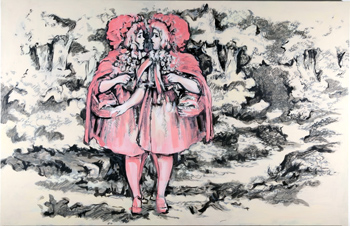FRACTURED FAIRY TALES
What big talent you have
By Doug MacCash, NEW ORLEANS TIMES-PICAYUNE
“Innocent Act,” Stephen Paul Day’s new collection of strangely beautiful, small-scale sculpture at Arthur Roger Gallery was inspired by the “Little Red Riding Hood” fairy tale. But not the softened, sanitized cartoon versions that most of us know best. Day’s take on Little Red is based on the 19th-century Brothers Grimm version of the traditional German folk tale, which has plenty of psychological/sexual/mythic/moral subplots, plus an ending that’s more Martin Scorsese than Walt Disney.

”The Meeting”, by Stephen Paul Day, which symbolizes self-discovery.
“The Grimms” tale begins with a girl that everybody loves,” Day explained, “but she does something wrong, she strays from the path. That’s when she takes a bite of the (forbidden) apple and meets the wolf, which is like the serpent in Genesis, right? Then she tells him the thing she shouldn’t tell him: Where grandmother lives.
“The wolf goes to grandmother’s house and he kills her and eats her. Then Little Red Riding Hood arrives and comes in and she crawls into bed with grandma and says ”What big this you have and what big that.” Then the wolf eats her. But then the woodsman, who is the god or the hero figure of the story, comes in and he kills the wolf with an ax, then cuts open the wolf and out pops Little Red Riding Hood and grandmother. He fills the wolf with rocks, sews him together, throws him in the river and drowns him. That’s the Grimm version.”
It doesn’t get much grimmer.
The gory fairy tale crescendo accounts for the ominous ax motif that slices through the exhibit. In one bronze casting, small axes are hacked side by side into a branch like menacing song birds. In another, an ax splitting a juicy apple forms a surrealistic phallus. In still another, seven identical axes stand butt to butt, forming a macabre star. And on a wall-mounted television screen, an enigmatic video loop (what contemporary art video is not enigmatic?) presents a woodsman chopping sticks, then apples, on a stump.
But the show’s sharp edges are softened somewhat by whimsical bronze and cast-glass sculptures of little girls, representing innocence and wonder. A spray of orchids bursts from one child’s head like a daydream. Another young girl playfully faces off with a friendly house cat. Several other little girls are cast as conjoined twins, their foreheads disquietingly merged. The twins, Day explained, are meant to symbolize harmony and self-discovery.

Stephen Paul Day”s ”History of Beauty” is made of translucent, apricot-colored cast glass
Day, who splits his time between New Orleans and Cologne, Germany, sees the potential intersection of the ax blades and conjoined twins as the show”s principal source of dramatic tension.
“In a fairy tale,” he said, “you always have a beginning when everybody’s happy in the forest. Then there’s something that happens in the forest that causes a kind of energy and there’s a moral at the end. That’s why I wanted to set up the show as an energy system, not as a narrative. So I used the idea of the joining or connection (the conjoined twins) and to disconnect things I chose the ax.”
“Innocent Act” is the sort of eerily thoughtful, energetic and engaging exhibit we’ve come to expect from Day, 50, one of the Crescent City”s premier postmodernists. But unlike his past shows, with themes like classical opera and the plays of Tennessee Williams that appealed to a relatively narrow audience, “Innocent Act” should have universal appeal. Day says the Little Red Riding Hood theme was inspired in part by his mother who died last year.
“This time I decided to do a show for myself and I dedicated it to my mom,” he said. “I asked myself what she would like and what she gave me. … She introduced me to fairy tales and horror movies. She loved the quirky and weird side of life.”
